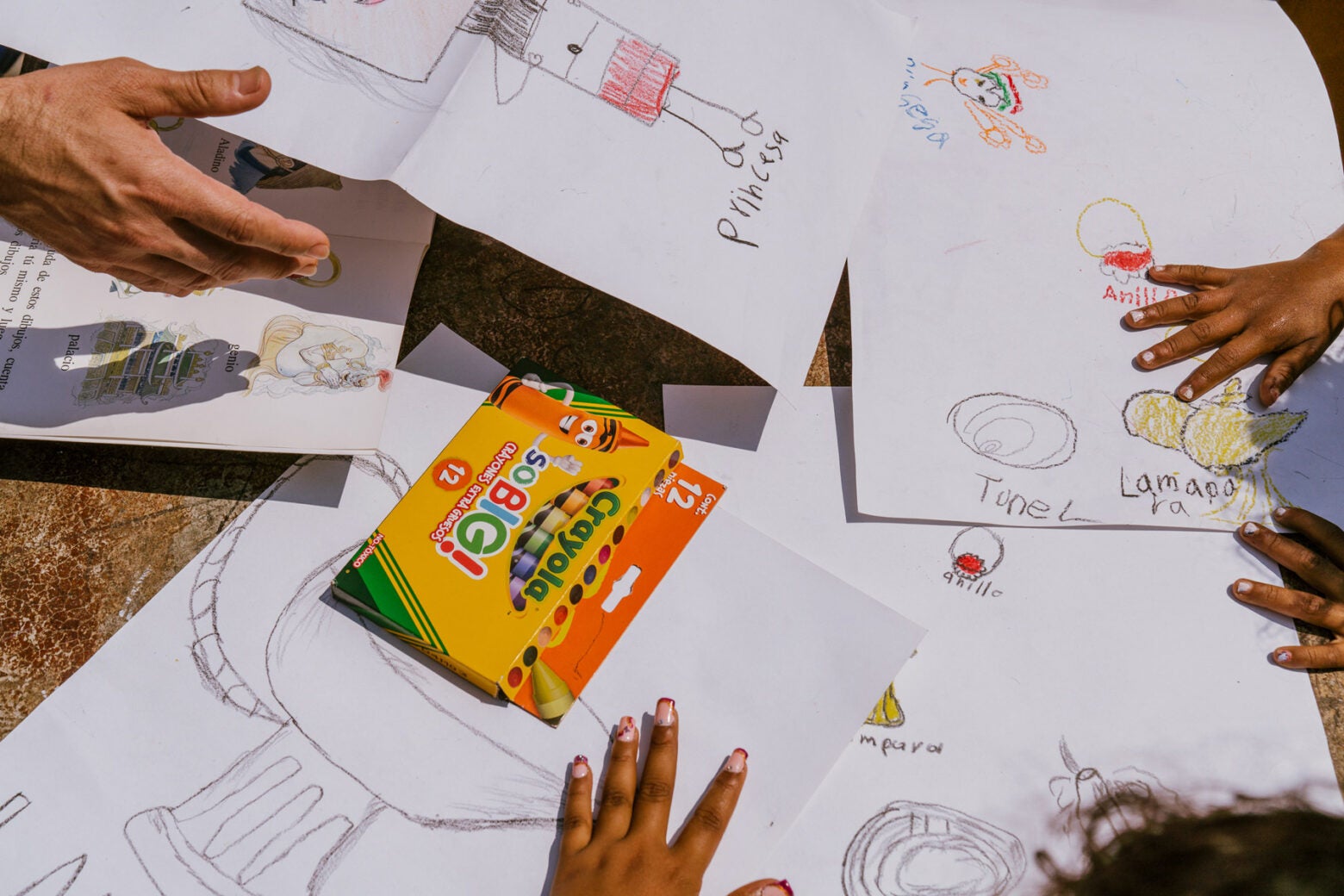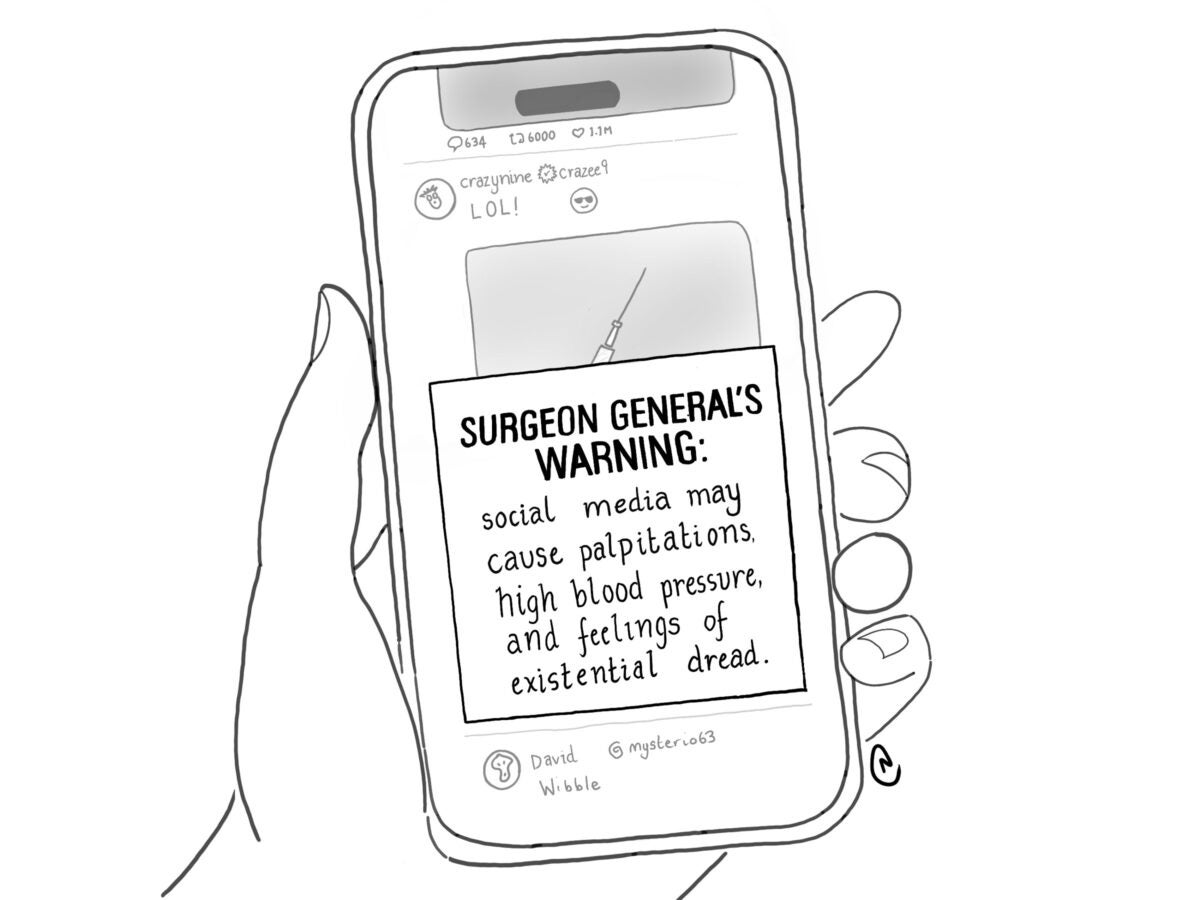
Isaac Contreras, 40, a Mexico-City based sculptor, talks with a girl living in the encampment at Plaza Soledad about the art they made at a workshop led by the nearby church. Contreras volunteers with children at previous encampments in Mexico City.
Feature
Migrant children struggle to express themselves in words. Enter art and play.
When Isaac Contreras moved back to Mexico City in early 2024, Plaza Giordano Bruno, across the street from his apartment, became a familiar sight. Locals know the plaza for its ominous, hooded statue of the eponymous philosopher, and, now, for hundreds of Haitian and Central and South American migrants who have camped there over the years while waiting for a United States immigration appointment. Contreras watched every day as the migrants’ lives unfolded in public. And he wanted to help the kids.
So he approached the Plaza Giordano camp with papers and markers. As an artist, he understood the power creativity could unleash, and he asked them to draw how they got to Mexico. The pictures shocked him. “There were kids who expressed their passage through the jungle—how they were assaulted, robbed,” Contreras recalls.
Sign up for Harvard Public Health
Delivered to your inbox weekly.
The approximately 60-mile stretch through the Darién Gap—the “land bridge” that connects North and South America along southern Panama and northwestern Colombia—is a common route for migrants from Africa, Asia, and Central and South America searching for the American Dream. In the first half of this year alone, nearly 198,000 migrants crossed there, according to the Panamanian government. It is an arduous journey fraught with dangers natural and human—predatory animals, scarce food, as well as violence, robberies, and sexual assault, whose victims include children.
“[A] five-year-old that’s crossed three countries, [through] the jungle—that’s not a typical experience for a boy or girl of that age, right?” Contreras says. “That’s when I realized [art] was indispensable for them…. It could give their experiences a shape.”
Art, games, and toys are proving powerful tools for addressing the mental health and trauma of migrant youth in Mexico. With initiatives from individual volunteers like Contreras, as well as psychologists and humanitarian organizations like Doctors Without Borders (which even produced an animated film with children’s drawings), unstructured play is becoming an important if under-discussed part of the humanitarian response in Mexico City and along the U.S.-Mexico border.


Children play and draw at a migrant encampment in Plaza Soledad in Mexico City in October.
Research shows that play therapy and art therapy are important for child development and can allow children to process complex trauma. One 2022 study found that art can promote feelings of hope, empowerment, and optimism among kids with minor mental health difficulties. Art can also be important, the same study showed, “for expressing complex emotions and feelings that cannot be easily verbalized.” And a wealth of scientific studies show that a child who has experienced trauma but has “one trusted adult” in their lives is less likely to experience negative mental health outcomes, and more likely to develop self-confidence.
Contreras became that trusted adult for many kids at the plaza. He began holding an informal “school” for two to three hours, Monday through Friday. Most of his “students” hadn’t been in school for months, a risk factor for negative mental health and learning loss. Contreras became “profe,” shorthand for “teacher” in Spanish, and his “class” grew to 20 migrant kids. “They’d always ask me, ‘Are you going to come? Are you going to come?’” he says.
During Mexico’s Children’s Day, Contreras put on a public art exhibition of the kids’ work. Haitian kids sang in their native Haitian Creole, and Contreras projected their drawings with a projector to show Juaréz “their humanity”—an initiative that felt especially important given its timing. In the months before the exhibition, neighbors had protested against the migrant camp and asked the government to shut it down—something the kids noted and sometimes interpreted as racism or hate, Contreras says. When they saw their drawings projected, he recalls, “they were so excited. They said, ‘I made this in school! I made this in school!’”
For kids living in migrant camps like the plaza, the unknown can cause anxiety. And there are many unknowns: When will the immigration appointment come? What will this new country be like?
Drawing “allows them to feel some sort of agency and control” and make sense of an uncertain situation, says Sita Patel, a community psychologist at Palo Alto University who specializes in mental health in immigrant communities. This January, she and other psychologists visited a migrant camp in the Mexico border town of Reynosa, Tamaulipas and asked kids to draw a house. Despite the kids’ reality of living in tents, details immediately sprang to mind: They drew their imagined future, she says.
Hope is a recurrent theme across the migrant camps of Mexico. Unprompted, 12-year-old Doriana, a Venezuelan living in the Plaza Soledad migrant camp in Mexico City’s downtown, imagined and drew her “new home” in the United States. It had a red-tiled roof, a tree in the backyard, and blue specks showering the scene to represent snowflakes, even though she’s never seen snow before.
Arturo Ortiz is doing similar work to Contreras, though from a different background and with different tools. A former professor of psychology at Universidad Nacional Autónoma de México in Mexico City, he took his last batch of students out of the classroom and down to the plaza for their final meeting of the academic year, in May. His ten students filed into the square; one held a garbage bag full of toys, balloons, and balls.
A handful of Plaza Giordano kids, mostly younger and Haitian, swarmed when they saw Ortiz’s students. The students gathered the children into a circle and passed around balloons; the children laughed and clapped. Some sat in students’ laps.

Arturo Ortiz, a professor previously working with the Universidad Nacional Autónoma de México in Mexico City, sits near the migrant encampment at Plaza Soledad in Mexico City.
This was the last day of play therapy for the kids and for Ortiz’s students, who had come to the plaza nearly every Saturday for the semester to engage the kids in unstructured fun. Ortiz hoped it would improve the mental health of the kids, who continued to be exposed to stress but lacked psychological resources.
Take David, a two-year-old Honduran child who still waddles when he walks. David’s seven-month-old sibling Homer caught pneumonia while in the camp—“he wasn’t used to the cold,” their mother, Daniela, says—and died in the hospital in April. Daniela was devastated. She kept Homer’s ashes by their tent, carrying them still when they finally got their visa and moved to Los Angeles. David, too young to understand death, still sometimes asks where his brother is.
Ortiz hoped play could unlock the “pain” to which David was exposed. “Games are like x-rays in psychology,” he says. They help adults peer inside the hearts of kids “because kids don’t have the verbal capacity to express themselves like adults.”
Children sometimes play at things they have experienced to process trauma, says Peter Gray, a psychology research professor at Boston College. This is true in a variety of traumatic settings, from the migrant border communities of today to the Jewish ghettoes of the Holocaust. George Eisen, professor emeritus of history at California State Polytechnic University, says play helps children “understand, to learn or maybe also accommodate reality.” Eisen wrote a book about play during the Holocaust, documenting how Jewish children played make-believe Gestapo agents, among other games that mimicked their reality. “They are preparing themselves in some ways if it happens to them,” Eisen says. “It’s how they cope.”
Doctors Without Borders uses play when visiting the youth in Mexico City’s migrant camps for similar reasons. “It’s very stressful for them. You see when they arrive… they are tired because they had a very long journey,” says Valeria Reyes, a community strategies and health promotion manager with the organization. Her team builds playgrounds, offers toys, holds story time, draws and colors, and teaches health education lessons to the kids. “When they come to the playgrounds, [the kids] really enjoy it,” Reyes says. “They can feel free.”
Mateo, a gruff, three-year-old Haitian toddler who had lived in Plaza Giordano, was known for his perpetual frown—except when he got toys to play with. Once, two Mexican women delivered a bag of toys right to his tent. “JUGETES!!!” Mateo whooped, shouting the word for toys in Spanish—like many migrant kids, he picked the language up in Mexico—and holding the bag of plastic building blocks over his head like a tribute won in a conquest. “Yeah, yeah, yeah!”


Children play soccer and ride tricycles at the migrant encampment in Plaza Soledad in October.
Play also allows youth, especially teens, to take risks, to be independent, and to take control of their lives, which is essential for psychological development. “Children, like the rest of us, need periods of time where we are not being controlled by other people,” Gray says. “It’s extremely important that we allow children to have that time and opportunity to do those things.”
But in migrant camps that’s not always easy to achieve, as Joyce Zangilu, 13, knows. Zangilu’s whole world was confined to the Plaza Soledad migrant camp in Colonia Centro in Mexico City; her mother wouldn’t let her leave its bounds for fear of her safety—not to work under-the-table (because she’s also “too young”) nor go play with volunteers who come once a week. Worst of all, she says, her mother wouldn’t let her have a phone.
Zangilu admitted she’s stressed—the Angolan migrant has nightmares about the corpse she saw before entering the Darién Gap, the first dead body she’d ever seen. She hated living in a tent with her six siblings and mother. “I’m not really used to being poor.”
The little things she could control made her feel better: Telling people she’s 14 even though she’s 13, or renaming herself Joyce. (Her name is really Jordan, her sister whispered conspiratorially.) Zangilu destressed most when borrowing her friend’s phone to play music, removing herself from reality. Her favorite artists are angsty American popstars like Billie Eilish and Olivia Rodrigo. Once the music plays, Zangilu says, “I just calm down.”



